Investigating the Galaxy Nexus LTE Signal Issue
by Brian Klug on December 19, 2011 8:24 PM EST- Posted in
- Smartphones
- Verizon
- LTE
- Droid Charge
- Mobile
- galaxy nexus
- Android 4.0
It seems that each time an LTE handset comes out, there’s invariably some perceived issue with connectivity and stability. This time, focus is being placed on Verizon’s CDMA/LTE variant of the Galaxy Nexus, and the issue surrounds LTE connectivity robustness compared to the other LTE handsets out there.
I’ve been running battery life tests on our LTE Galaxy Nexus review unit since release day (a process that takes a considerable amount of time and results in our reviews posting a while behind everyone else’s), but have had some time to run tests and gauge subjective performance. I found that LTE connectivity and performance felt above average, subjectively, and noted that in a tweet. After complaints started to surface, I spent a considerable amount of time reading the threads on XDA and other places around the web trying to discern what the complaints are about. I’ve seen a couple of big misconceptions that I think really get to the heart of the matter.
First off, is some background. The Verizon CDMA/LTE Galaxy Nexus (codename “mysid”) uses a combination of Samsung CMC221 and Via Telecom CBP 7.1 for LTE and CDMA 1x/EVDO connectivity, respectively. This is virtually identical (unsurprisingly) to the Droid Charge, which used a CMC220 for LTE and the same CBP 7.1. The CMC22x family is UE Category 3, which currently is the highest for shipping devices and means it can handle up to 100 Mbps downstream with 20 MHz FDD. To date, all of the LTE basebands in Verizon LTE devices have been UE category 3 with the exception of Motorola’s devices, which are all UE category 2, but I digress. We’ve reached out to Samsung Semiconductor about what’s changed between CMC220 and 221, but doubtless the changes improve connection stability and reliability.
Speeds thus far have also been excellent. I’ve squeezed in 183 speedtests between battery life testing, and have seen some of the fastest LTE connectivity out of the Galaxy Nexus to date. After testing so many Motorola LTE devices with UE Category 2 modems, it’s refreshing to see this kind of performance out of a UE Category 3 device.
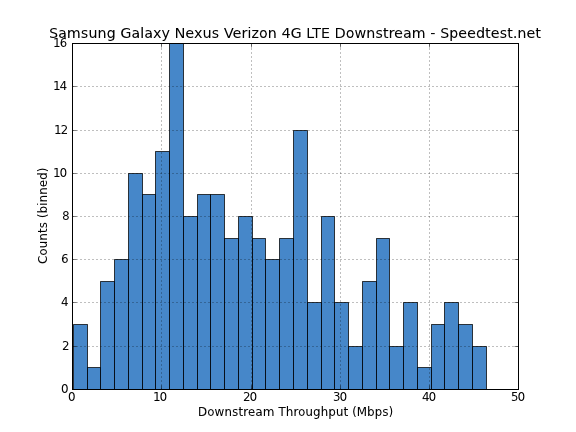
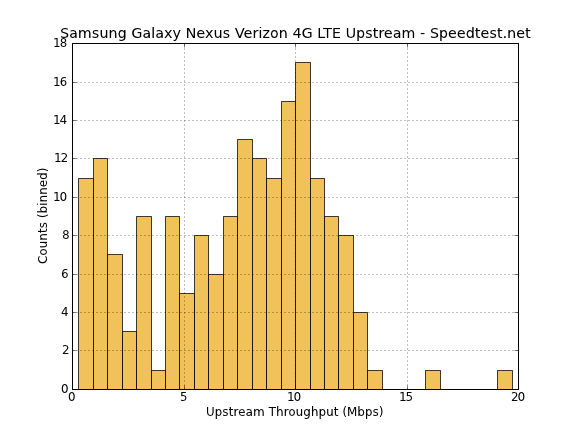
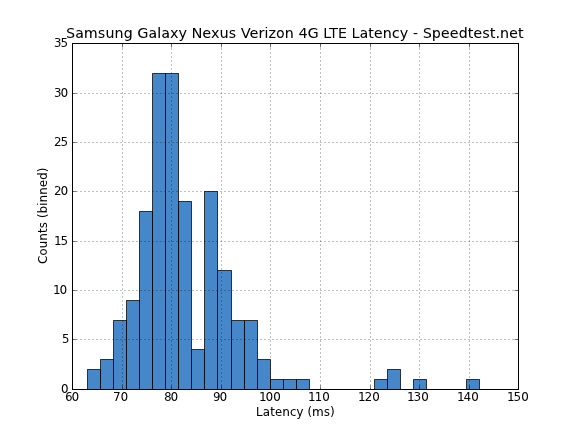
The issue that most people talk about centers around signal strength, and this is where a few misconceptions kick in. I’ve gotten a few emails and tweets and read pages on forums where people are implicitly comparing CDMA2000 1x/EVDO field strength to LTE field strength. The issue here is that on basically all of the LTE/CDMA Verizon handsets, the field under “Signal Strength” in about refers to EVDO signal strength, and not LTE signal strength. The two aren’t comparable at all for a host of reasons - different spectrum (800 MHz and 1900 MHz for 1x/EVDO as opposed to 700 MHz for LTE), and different cells (there’s some correlation, but not every Verizon base station has LTE onboard). The end result is that if you’re comparing 1x/EVDO signal strength to LTE signal strength, you’re making an absolutely meaningless apples to oranges comparison.
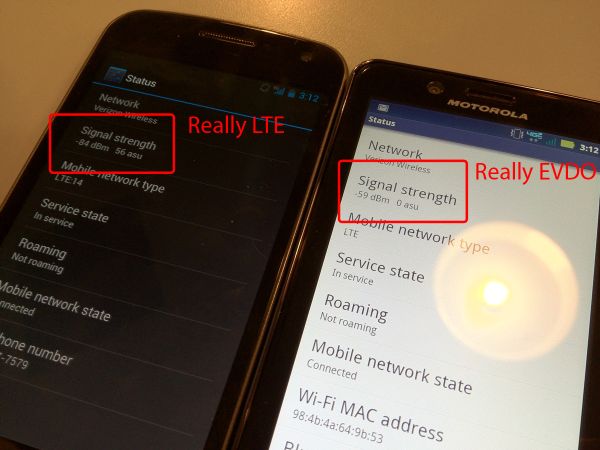
This is not a valid comparison - LTE versus EVDO signal strength
The Galaxy Nexus (and really just Android 4.0) now correctly reports and accommodates LTE by reporting its signal strength under “About->Status” and visualizing that as bars appropriately. Switch to EVDO on the Galaxy Nexus and signal strength appropriately changes to reflect an entirely different air interface’s signal strength. It’s nice to see people using dBm instead of bars when possible (which are effectively meaningless as a comparison metric), but now that there are multiple air interfaces on handsets, we have to be explicit about what numbers we’re actually comparing.
This reporting is a problem I’ve talked about at length in more than one LTE handset review, and to date I only know of ways to show LTE signal strength and channel quality on a few handsets. Samsung’s Droid Charge (courtesy Samsung’s excellent ServiceMode application viewed through *#0011# after some unlock trickery) and the Bionic (through logcat and grepping for the radio signal status daemon) report LTE field strength, but only if you dig for them.
Comparing LTE Signal Strength the Right Way
So how does the LTE Galaxy Nexus compare to the Droid Charge and Bionic, the two handsets we can actually view LTE signal strength in dBm on? Very closely as a matter of fact.
I have a Bionic kicking around which has to go back very soon, but fired up logcat and put the Galaxy Nexus next to it. The Bionic reports signal strength pretty constantly whereas in Android 4.0 the number has some hysteresis, but here the numbers are pretty darn close, with the Bionic hovering between -91 and -95 dBm, and the Galaxy Nexus reporting an average of -92 dBm.
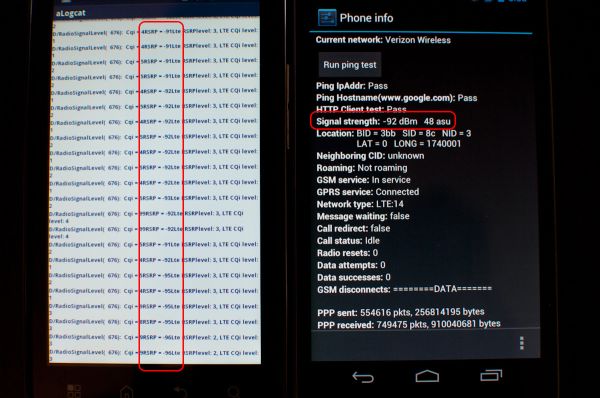
Left: Motorola Droid Bionic (logcat showing LTE signal strength), Right: Galaxy Nexus
Since the Droid Charge is the only other handset I know how to show LTE signal strength on, I tracked a friend down at a local cafe with one and fired up service mode. Again, what’s shown under “About->Status” on the Droid Charge is actually EVDO signal strength. Here the Galaxy Nexus shows -107 dBm and the Droid Charge shows -108 dBm.
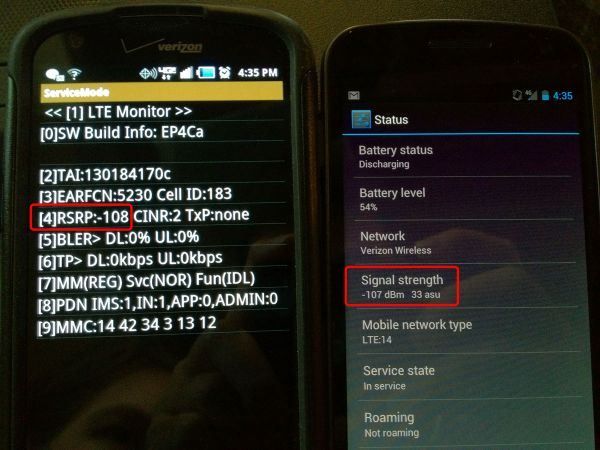
Left: Samsung Droid Charge (ServiceMode) Right: Galaxy Nexus
The Droid Charge is another hilarious example of why you can’t compare bars at all, as the Charge shows a positively laughable 4 out of 5 bars in an area with very low LTE signal strength, whereas the Galaxy Nexus (moreover, Android 4.0) has a very conservative and realistic strength to bars mapping. Carriers love to make things out to be better than they really are, however, and the result is this kind of hilarious visualization which portrays LTE signal as being much better than it really is if you stare at bars all day.
Verizon confirming though a tweet that there’s some sort of signal issue affecting the Galaxy Nexus confuses me, since from my perspective there isn’t any issue at all. The only real issue that exists is that the Galaxy Nexus (and really just the stock Android 4.0 signal strength to bars mapping) doesn’t line up with what Verizon has shipped on other devices, thus leading people to make apples to oranges comparisons and imagine an issue. I wager that some of this confusion is also compounded from the number of Verizon customers that are just now getting their first LTE handset with the Galaxy Nexus. It might be surprising to discover that LTE coverage right now isn't nearly as good as 1x/EVDO, but these things will improve as the carrier's LTE rollout continues. The other big disclamer is that I haven't fully investigated 1x/EVDO performance on the Galaxy Nexus, but this will end up being virtually identical to the Droid Charge.
There’s a CDMA and LTE baseband update coming with the LTE Galaxy Nexus’ 4.0.3 update as shown above, but this will likely do more to address connection stability than change the way anything is reported. Given how much attention this has gotten, however, I would not be surprised to see Google make a change to its signal strength to bars mapping for LTE and placebo away an issue that never really existed to begin with. That's also an unfortunate change, since from my perspective the Galaxy Nexus is one of the first handets that doesn't have an unrealistic mapping. In the meantime, we're still working on our Galaxy Nexus review where we'll take a complete look at the LTE/CDMA and GSM/UMTS Galaxy Nexii.
Update:
As predicted, Verizon has made a statement to The Verge and Computerworld stating that there's nothing wrong with the RF performance characteristics or baseband firmware on the LTE/CDMA Galaxy Nexus. Instead, they will upstream some changes to Android to make the device report its bars visualization in line with the rest of its 4G LTE hardware portfolio.
"[Verizon] will adjust the signal strength indicator to more closely match other Verizon Wireless devices.


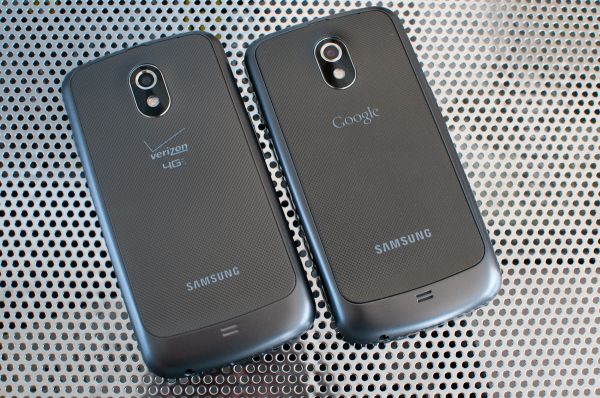









154 Comments
View All Comments
dcdttu - Wednesday, December 21, 2011 - link
I did. Care to elaborate?wogzi - Saturday, December 24, 2011 - link
Reading ain't skimmin, guy. There's a chunk of the article devoted to putting out a hypothesis as to why the 'bars' you see on the Charge are an exaggeration and the bars on the Nexus are more honest. A good counterargument would've been based in theory (ie 'science') and not you spitting out the very same mistaken perception that Brian enumerated on.Lord 666 - Monday, December 19, 2011 - link
While not scientific as signal strength readings, look at the history and current status of LTE. VZW is not being fully forthright. Hearing excuses that it is a new technology does not cut it since it been beta tested for over 2 years.1. Its only available on VZW Android handsets and tablets. Could it be battery life, heat, signal strength, or collusion?
2. VZW has had two major outages of LTE since last year's release.
Why?
3. VZW has delayed every LTE release and the Xoom upgrade dragged on.
Why?
4. VZW has painfully pushed back public and static IPs for LTE month after month. The only device that has limited support is the 55 usb card, but that device is horrible all around. Why?
prisonerofcs - Monday, December 19, 2011 - link
I live in an area without LTE coverage at all. My OG droid typically had 3-4 bars in my home and 5 bars at work. Download speeds average 900K at work. It now has no signal at home (not just no bars, but no signal - can't connect to the internet) and at work averages 120K downloads. At home sitting on the same table as my cisco e3000 router it gets 3 bars of wifi. At work sitting an office away to our cisco access point it gets 2 bars. In both locations my old droid got 5 bars of wifi.I went to tampa this weekend (which has LTE) it found the 4g signal pretty quick but as soon as I tried to load a webpage I lost all connectivity. I had to reboot the phone, it found 4g again, and lost connectivity. I turned off LTE and forced it into CDMA only, and hung on to 2 bars of 3g.
I had Verizon swap my Galaxy Nexus for another. The weak signal is at least as bad at home. I haven't tested the other scenarios yet.
This problem is very real. There seem to be some people who are getting lucky, but I believe the vast majority of us are suffering these problems. Its extremely disappointing because I love everything else about the phone, but if I can't reliably make calls, whats the point of paying almost $100/month for a phone.
pedrobeach - Monday, December 19, 2011 - link
I am going to swap for a Razr while Brian theorizes about isotrophy. I bet I get LTE at home after the switch.Brian Klug - Monday, December 19, 2011 - link
I have a RAZR right here with me (currently on my desk are the Bionic, RAZR, and Galaxy Nexus) and all perform the same. Again I see many implicit comparisons with EVDO which just cannot be made.-Brian
bplewis24 - Monday, December 19, 2011 - link
I'm with Brian here. I had a Bionic before purchasing the Nexus. While the Bionic constantly reported stronger signal strength, it dropped 4G just as often as the Nexus does. Additionally, the Nexus has a strong 3G connection for me.Brian Klug - Monday, December 19, 2011 - link
And even better, it's a higher UE category than any of the Motorola phones, so it can hit higher downstream throughput in better signal environments.I guess the issue really is communicating and explaining that 1x/EVDO signal != LTE signal. The cell layout is different, the propagation characteristics are different, and you just can't compare coverage that way. It's deceptive because all the previous phones showed the wrong thing in "About-Status" and people simply assumed that was really LTE signal.
-Brian
bplewis24 - Monday, December 19, 2011 - link
"you just can't compare coverage that way. It's deceptive because all the previous phones showed the wrong thing in "About-Status" and people simply assumed that was really LTE signal."-------------------------
This is the point I'm stressing on the AndroidCentral.com forums. If it isn't an apples-to-apples comparison, then it's essentially worthless for using as anecdotal data.
I look forward to your full review of the LTE Nexus, Brian.
Brian Klug - Monday, December 19, 2011 - link
Yeah, the cells are laid out differently, and I've seen places with absolutely great (-50 dBm or better) EVDO signal and close to cutoff LTE signal (-100 dBm or worse is almost nothing). It's really a problem that has been created as a result of virtually every phone but the LG Revolution showing LTE signal wrong.I guess one point I didn't make either was that I still haven't finished coming up with some intelligent conclusions/data about EVDO at all. Via 7.1 is a new part in the US, and that's where I think people have seen voice issues and 3G data problems.
-Brian